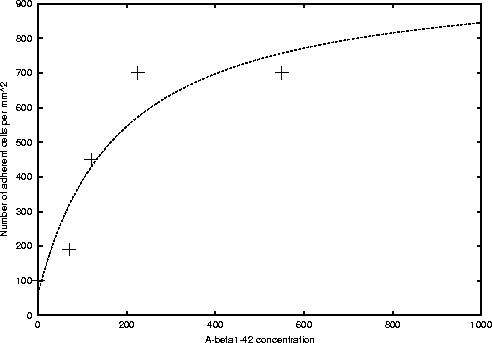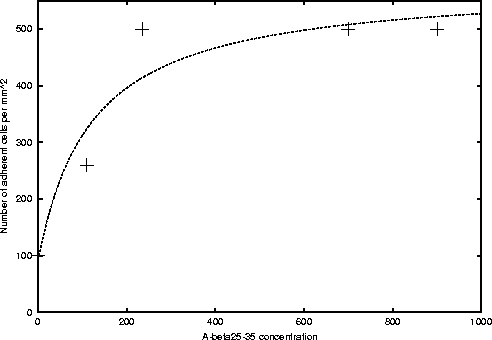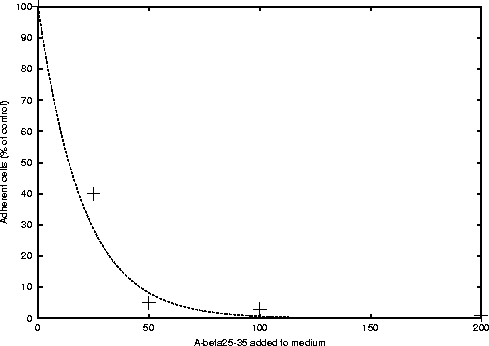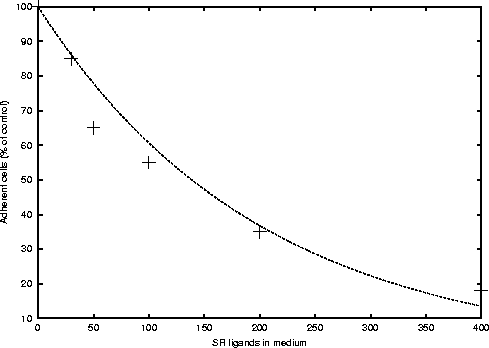Microglia adhesion to beta-Amyloid
fibrils
Senile plaques found in the brain of Alzheimer's disease patients are
formed by beta-Amyloid fibrils, microglia and astrocyte cells. Beta-Amyloid
fibrils stimulate microglia to secrete neurotoxins such as different kinds
of reactive oxygen species.
El Khoury et al [1] investigate the way microglia sticks to beta-Amyloid
fibrils. Specifically, they study a particular type of scavenger receptors
(A class SR) that mediate adhesion of rodent microglia and human monocytes
to beta-Amyloid fibrils (fAß). Moreover, cell adhesion to
non-fibrillar forms of beta-Amyloid (Aß) is also analysed.
In particular, fibrillar and non-fibrillar forms of Aß1-42
and Aß25-35 are considered. Both, activate microglia and other
phagocytes. El Khoury et al. show that adhesion of mouse N9 microglia
and human monocytes to surfaces coated with fAß takes place
in a dose dependent manner. Furthermore, in order to compare adhesion to
Aß, they also consider adhesion to collagen IV (CIV), a matrix
protein also found in senile plaques.
|
Figure 1: Michaelis-Menten curve fitted to the data
obtained from figure 1a of El Khoury et al. [1]. Microglia cells
adhere to fAß1-42 in a saturated manner.
|
|
In figure 1a of their paper [1], maximal adhesion of approximately 700
cells/mm2 occurs at 225 nM of fAß1-42. Also maximal
adhesion of 500 cells/mm2 happens at 235 hM
of fAß25-35. At the same time it is shown that few N9 cells
or monocytes adhere to surfaces coated with CIV, and the non-fibrillar
form of Aß1-42. The range of Aß concentration
considered was from 0-1000 nM.
|
Figure 2: Michaelis-Menten curve fitted to the data
obtained from figure 1a of El Khoury et al. [1]. Microglia cells
adhere to fAß25-35 also in a saturated
manner.
|
|
For the number of adherent cells per mm2, and the fAß1-42
concentration in nM, we have the following data from fig 1a of El Khoury
et al. [1]: [(0,100), (70,190), (120,450), (225, 700), (550,700)].
Let us consider c as the number of adherent cells/mm2, and x
as the fAß1-42 concentration. By using the nonlinear least-squares
(NLLS) Marquardt-Levenberg algorithm, we were able to approximate the Michaelis-Menten
function
where, cmax = 925.127, K = 182.524 and co = 62.30
(see figure 1) to the above data.
On the other hand, for the case of fAß25-35 concentration
also in nM, the data obtained is [(0,100), (110,260), (235,500), (700,500),
(900,500)]. And the approximate function estimated is
where, cmax = 488.063, K = 121.0, co = 91.904 (see
figure 2).
|
Figure 3: Exponential decay curve fitted to the data
obtained from figure 1b of El Khoury et al. [1]. Soluble Aß25-35
blocked N9 cell adhesion to CIV/fAß1-42
coated surfaces in a concentration-dependent manner.
|
|
Figure 1b of El Khoury et al. [1] shows how soluble Aß25-35
blocked N9 cell adhesion to CIV/fAß1-42 coated surfaces in
a concentration-dependent manner. From an initial concentration of 100%
of adherent cells, we suggest an exponential decay reaching almost zero
concentration at 200 µM of Aß25-35. The data
roughly obtained from the figure is [(0,100), (25,40), (50,5), (100,3),
(200,1)]. The half-life point happens at approximately 25 µM
of Aß25-35. We have just performed an eye approximation to
these data with the exponential decay function
where, co = 100 and k = 0.05 (see figure 3).
|
Figure 4: Exponential decay curve fitted to the data
obtained from figure 1c of El Khoury el at. [1]. SR ligands interfere
in N9 cells and monocyte adhesion to surfaces coated with CIV/Aß25-35
or CIV/Aß1-42 in a dose dependent manner.
|
|
Then, it was also shown that SR ligands block adhesion of primary rat
microglia, N9 cells, and monocytes to surfaces coated with CIV/Aß25-35
or CIV/Aß1-42 in a concentration- dependent manner. Figure
1c shows what we guess is an exponential decay of 100% of adherent cells
with respect to a SR ligand concentration ranging from 0-400 µg/ml.
With the cell adhesion half-life occurring at approximately 120 µg/ml
of SR ligands. Thus, the data roughly obtained is [(0,100), (30,85), (50,65),
(100,55), (200,35), (400,18)]. And the eye-fitted function we propose is
given by
where, co = 100 and k = 0.005 (see figure 4).
Therefore, it is suggested that primary rodent and human microglia express
class A macrophage SR. Class A SRs promote cell adhesion to fAß.
The collagen-like domain of SR is responsible for SR-ligand binding. A
synthetic peptide (SP1) identical to residues 323-339 of the collagen domain
of mouse SR also blocked adhesion of N9 cells or primary rat microglia
cells to CIV/fAß25-35 coated surfaces in a concentration-dependent
manner. Figures 2a of El Khoury et al. [1] shows 100% of adherent
microglia cells decrease exponentially for a SP1 concentration ranging
from 0-700 µg/ml.
Moreover, Aß and ligands of macrophage SR added to suspension
induce monocytes to secrete reactive oxygen species (ROS). ROS produced
by microglia adhering to fAß coated surfaces was examined.
Figure 2b shows that N9 cells incubated in CIV/fAß25-35 coated
surface produces four times more ROS that N9 cells incubated only in CIV
coated surfaces.
Chemotactic migration of microglia was also examined. TNF-alpha
is a chemoattractant/cytokine produced by microglia. Without chemoattractant
30% of microglia migrated across CIV coated surfaces. However, with TNF-alpha
a 2-fold increase of microglia migration was induced. When adding fAß
to a CIV-coated filter, both spontaneous and TNF-alpha
stimulated migration of primary microglia cells were inhibited almost completely
(see figure 3 of the paper). These experiments suggest that fAß
act in vivo to retain these cells at sites of fAß deposition.
It is suggested that microglia cells adhere to fAß via
their class A SR in attempt to clear them from the extracellular milieu.
But once microglia are at the fAß, the high density of SR
ligands present causes immobilisation of microglia cells, and induce them
to produce cytokines, ROS and nitrogen species that injure neighbouring
neurons. That is why the study of SRs is important and the possibility
of producing compounds that may block interactions between microglia class
A SRs and fAß is suggested for treatment of Alzheimer's disease.
Reference:
[1] El Khoury J, Hickman S E, Thomas C A, Cao L, Silverstein S C, Loike
J D (1996) Scavenger receptor-mediated adhesion of microglia to beta-Amyloid
fibrils, Nature 382: 716-719.
File translated from TEX by TTH,
version 2.60.
On 27 Jan 2000, 00:33.




